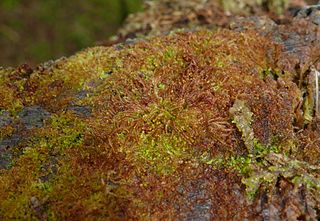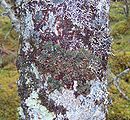
A lichen is a hybrid colony of algae or cyanobacteria living symbiotically among filaments of multiple fungi species, along with yeasts and bacteria embedded in the cortex or "skin", in a mutualistic relationship. Lichens are the lifeform that first brought the term symbiosis under biological context.

The Marchantiophyta are a division of non-vascular land plants commonly referred to as hepatics or liverworts. Like mosses and hornworts, they have a gametophyte-dominant life cycle, in which cells of the plant carry only a single set of genetic information. The division name was derived from the genus name Marchantia, named by French botanist Jean Marchant after his father.

Cyanolichens are lichens in which the fungal component partners with cyanobacteria for photosynthesis, rather than the green algae found in most other lichens. In some cyanolichens, known as bipartite forms, the cyanobacteria form an extensive photobiont layer throughout the main body of the lichen. Others, called tripartite lichens, contain both green algae and cyanobacteria, with the latter often confined to specialised wart-like structures known as cephalodia. This arrangement reflects the remarkable diversity within cyanolichens, which can feature filamentous or unicellular cyanobacteria, sometimes exhibiting multiple independent evolutionary origins across different fungal lineages.

Erioderma pedicellatum is a medium-sized, foliose lichen in the family Pannariaceae, commonly called the boreal felt lichen. It grows on trees in damp boreal forests along the Atlantic coast in Canada, as well as in southcentral Alaska, the Kamchatka Peninsula, and Norway.

Ptilidium californicum, the Pacific fuzzwort, is a rare liverwort of the western United States.

Frullania polysticta is a species of liverwort in the family Frullaniaceae. It is found only in Madeira and the Canary Islands and is considered a vulnerable species.

Lobaria pulmonaria is a large epiphytic lichen consisting of an ascomycete fungus and a green algal partner living together in a symbiotic relationship with a cyanobacterium—a symbiosis involving members of three kingdoms of organisms. Commonly known by various names like tree lungwort, lung lichen, lung moss, lungwort lichen, oak lungs or oak lungwort, it is sensitive to air pollution and is also harmed by habitat loss and changes in forestry practices. Its population has declined across Europe and L. pulmonaria is considered endangered in many lowland areas. The species has a history of use in herbal medicines, and recent research has corroborated some medicinal properties of lichen extracts.

Pleurozia is the only genus of liverworts in the family Pleuroziaceae, which is now classified in its own order Pleuroziales, but was previously included in a broader circumscription of the Jungermanniales. The genus includes twelve species, and as a whole is both physically distinctive and widely distributed.
Dictyonema is a genus of mainly tropical basidiolichens in the family Hygrophoraceae.

A cephalodium is a small gall-like structure found in some lichens. They occur only in lichens which contain both cyanobacterial and green algal partners. Cephalodia can occur within the tissues of the lichen, or on its upper or lower surface. Lichens with cephalodia can fix nitrogen, and may be an important contributor of nitrogen to the ecosystem.

Menegazzia terebrata is a species of foliose lichen found scattered across many continents, including North America, South America, Europe, Africa, and Asia.

Lobaria scrobiculata, commonly known as the textured lungwort, is a large foliose, epiphytic lichen in the family Peltigeraceae.

Crustose lichens are lichens that form a crust which strongly adheres to the substrate, making separation from the substrate impossible without destruction. The basic structure of crustose lichens consists of a cortex layer, an algal layer, and a medulla. The upper cortex layer is differentiated and is usually pigmented. The algal layer lies beneath the cortex. The medulla fastens the lichen to the substrate and is made up of fungal hyphae. The surface of crustose lichens is characterized by branching cracks that periodically close in response to climatic variations such as alternate wetting and drying regimes.

Lichens are symbiotic organisms made up of multiple species: a fungus, one or more photobionts and sometimes a yeast. They are regularly grouped by their external appearance – a characteristic known as their growth form. This form, which is based on the appearance of vegetative part of the lichen, varies depending on the species and the environmental conditions it faces. Those who study lichens (lichenologists) have described a dozen of these forms: areolate, byssoid, calicioid, cladoniform, crustose, filamentous, foliose, fruticose, gelatinous, leprose, placoidioid and squamulose. Traditionally, crustose (flat), foliose (leafy) and fruticose (shrubby) are considered to be the three main forms. In addition to these more formalised, traditional growth types, there are a handful of informal types named for their resemblance to the lichens of specific genera. These include alectorioid, catapyrenioid, cetrarioid, hypogymnioid, parmelioid and usneoid.

Lichen anatomy and physiology is very different from the anatomy and physiology of the fungus and/or algae and/or cyanobacteria that make up the lichen when growing apart from the lichen, either naturally, or in culture. The fungal partner is called the mycobiont. The photosynthetic partner, algae or cyanobacteria, is called the photobiont. The body of a lichens that does not contain reproductive parts of the fungus is called the thallus. The thallus is different from those of either the fungus or alga growing separately. The fungus surrounds the algal cells, often enclosing them within complex fungal tissues unique to lichen associations. In many species the fungus penetrates the algal cell wall, forming penetration pegs or haustoria similar to those produced by pathogenic fungi. Lichens are capable of surviving extremely low levels of water content (poikilohydric). However, the re-configuration of membranes following a period of dehydration requires several minutes at least.

Nowellia curvifolia is a species of liverwort belonging to the family Cephaloziaceae. It is a small, delicate plant that forms prostrate growths on rotting logs in forests throughout the northern temperate and subarctic regions. The species is distinguished by its distinctive billowed leaves arranged in two rows, each divided into two pointed lobes with the lower lobe forming a specialised water-holding pocket called a water-sac. The plant shows seasonal colour variation from rose to purple to brown to spring green, developing reddish-purple pigmentation in autumn and winter. It reproduces both sexually, through spores produced in reddish-brown capsules, and asexually via single-celled gemmae. N. curvifolia serves as an indicator species in forest ecosystems, particularly in montane spruce-fir forests, where it often forms pure mats on decorticated logs and is associated with the slime mould species Barbeyella minutissima.

Parmelia fraudans is a species of foliose lichen in the family Parmeliaceae. It is found in Europe and North America, where it grows on rocks.
John E. Braggins is a New Zealand botanist and bryologist, known for his research into ferns and liverworts. Braggins lectured at the University of Auckland from 1969 until 2000, during which time he supervised and mentored a significant number of New Zealand botanists. During Braggins' career, he has taken part in the identification of 12 species and one suborder, many of which are endemic New Zealand liverworts.

Saxiloba is a genus of lichen-forming fungi in the family Porinaceae. It comprises three species of saxicolous (rock-dwelling) placodioid lichens, known from disjunct locations in the Caribbean, Hawaii, and Brazil. The genus was circumscribed in 2020 to accommodate species with a distinctive placodioid thallus featuring unique surface patterns and internal crystal structures. Saxiloba lichens are characterised by their flattened, leaf-like thalli with marginal lobes, growing tightly appressed to rock surfaces. They have a complex internal structure, including large crystal clusters embedded within the photobiont layer, which may be an adaptation for light management in their typically shaded habitats.
Pseudopeltula is a genus of lichen-forming fungi in the family Gloeoheppiaceae. Established in 1995 by the lichenologist Aino Henssen, the genus currently includes four recognised species. These small cyanolichens are characterised by their squamulose (scaly) to peltate (shield-shaped) thalli, which lack a lower cortex and are attached to the substrate by rhizines. A key feature of Pseudopeltula is its complex apothecia, which have hymenia that often become divided by sterile tissue as they mature. The genus is primarily found in arid and semi-arid regions of North America, Mexico, and the Caribbean, where species typically grow on soil, rock, or thin soil over rock, often forming part of biological soil crusts in desert environments.



















